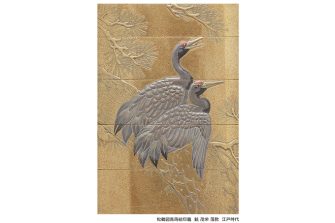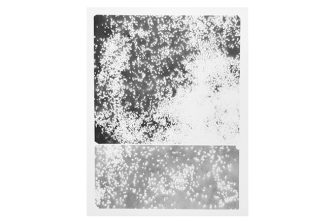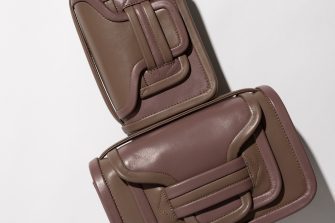
GSIXというロゴタイプに込めたのは、銀座の持つ軸性 Imbuing the “GSIX” Logotype with Ginza’s Poise
VISUAL IDENTITY
原研哉
銀座にふさわしいロゴタイプとは
銀座という街はピシッとした「軸」を持っていると思うんです。例えば同じ東京の繁華街でも、六本木なんかはぶれてもいいし、むしろぶれているものが集合することが魅力になっているかもしれない。新宿はエネルギッシュな混沌の極みでいい。ですから今回、GINZA SIXというとても大きな商業施設ができてハイブランドも多数入ってくると聞いたとき、ロゴタイプを中心とするVI(ヴィジュアル・アイデンティティ)にはあらゆるものを支える、相当に強靭な「軸性」が必要だと思いました。
一方で谷口吉生さんの建築は派手なテクノロジーや意匠を詰め込んで「すごい!」と言わせるようなものではなく、極めて静的でミニマルです。そういう建築に寄り添おうとするとき、ロゴだけが華奢だったりディテールが賑やかだったりすると、建築の力を削ぐような気がしました。簡潔なものは同じ世界観でつながっていかないと意味がないんですね。
結果、今回のロゴも「こんなにシンプルでいいの?」というものになりました。簡潔ゆえ、ラグジュアリーやファッションだけでなく、伝統文化やハイテクノロジー、コンテンポラリーアート…あらゆるシーンに寄り添えるものになっていると思います。
ちなみに、メインのロゴとして「GSIX」が立っていますが、当初の課題は「GINZA SIXで作ってほしい」というものでした。ただ、私は1983年に日本デザインセンターに入社してからもう33年も銀座が仕事場で、ビルにしても店舗にしても銀座という名前の付いたところばかりだなとちょっと飽きてしまっていて…(笑)。そこで「GSIX」と短縮形を提案しました。
色は「G」だけをゴールドにしています。僕にとって銀座のイメージカラーは金色です。銀座なのでシルバーと言いたいところですが、先ほども話した「軸性」にふさわしい色だと思います。
A Logotype Fit for Ginza
If you ask me, Ginza is a shopping district that has poise. Look at other bustling areas here in Tokyo: Roppongi can be indecisive and even insecure, and you could even say that its very charm lies in it being a hodgepodge of ambivalent ideas. Then there's Shinjuku, which is brimming with energy and is the epitome of chaos—in a good way. So when word came to me that a large shopping mall called GINZA SIX was being built with many high-end brands among its tenants, I knew that the logotype and the entire visual identity around it had to have the kind of solid backbone that can stand the test of time.
At the same time you have Yoshio Taniguchi, whose architecture is not the kind that wows you with showy technology or excessive design—rather, it is extremely static and minimal. When you think about how closely the logo will be associated with the building itself, and vice-versa, a logo that disregards the overall aesthetic and is too refined or too festive may unintentionally subvert the power of the architecture. If the architecture and the visual identity were both going for simplicity, it had to be within a unified aesthetic—otherwise, there would be a disconnect.
Consequently, the final logo for GINZA SIX ended up being surprisingly simple. But it's that simplicity that gives it almost universal applicability, whether it's luxury, fashion, traditional culture, cutting-edge technology, contemporary art...you name it.
Incidentally, the main logo is comprised of the letters "GSIX", but initially I was asked to use the full name "GINZA SIX". But as someone who has been working in Ginza for 33 years since I first joined the Nippon Design Center in 1983, I had seen so many buildings and shops with "Ginza" in the name that it had become cliché…(laughs). So I proposed an abbreviated form: "GSIX".
As for the color, only the "G" is gold. In my mind, if Ginza was a color, it would be gold. You were probably expecting me to say "silver" [Ginza means "silver mint"], but for me, gold captures its poise.

ファサードを飾るサインと建築との関係
ファサードのサイン計画というのはどうしても建築ができた後に付加されるイメージがあります。文字の後ろに光を当ててロゴを浮かび上がらせて、といったものが多いのですが、GINZA SIXでは「GSIX」のサインが建築の中に埋め込まれ、はまり込んでいます。夜になると建物の内部から、文字が白く浮かび上がるような印象となります。これは建築と一体で計画しないと成立しません。ですから、銀座通りのビル群のファサードの並びのなかでより緻密に見えるというか、全然違う質と印象を与えてくれるのではないかと期待しています。
また、GINZA SIXの1階に居並ぶハイブランドのロゴと並んでも、「GSIX」のロゴが負けることなく屹立するとともに、それらを支えなければならない。そこで発揮されるのはやはり、ロゴの簡潔さに由来する「軸性」だと思います。
銀座の大通りにある大概のビルは、1964年の東京オリンピックのときにできあがったと聞きました。きっと2020年の東京オリンピックを契機として、銀座はまた生まれ変わっていくでしょう。そのときにどの建築家もデザイナーも、ステレオタイプではない日本を、つまり、江戸の紋章や水引の造型をそのまま持ち出すようなものではなく、どう未来的に表現するかを考えていくはずです。銀座は昔も今も日本を経由した新しい生長点を意識している街なのです。
そういう意味でGINZA SIXのロゴは「和」でもあり、外から来た人々をどう迎え、応接するか。そのあたりを考えながら作っています。
The Relationship Between Facade and Sign
Plans for the sign on the facade usually come after the building has been completed; often the logo is simply attached to the front of the building and backlit to give it a three-dimensional appearance. But with GINZA SIX, the GSIX s"ign is embedded in the architecture and illuminated at night from within the building—giving it a distinctive white glow. For this to happen, the building letters had to be designed together with the architecture. So I'm confident that this facade will be able to hold its own along the stretch of facades on Ginza main street [Ginza's main shopping thoroughfare, Chuo-dori]. My hope is that it leaves a singular, lasting impression on customers and passersby alike.
And of course, the GSIX logo has to be able to stand above the logos of the high-end brands that will occupy the ground floor of GINZA SIX. But at the same time it has to be able to give them the space to shine. That's where, I think, the logo's solid backbone will do the heavy lifting.
Someone once told me that the majority of the buildings on Ginza main street were built to coincide with the 1964 Tokyo Olympics. Perhaps the 2020 Tokyo Olympics will be an opportunity for Ginza to undergo a renaissance. In the coming years I am sure all of the architects and designers involved in local projects will be inspired to design the Tokyo of tomorrow, rather than rehash stereotypical Japanese designs, such as Edo Period family crests and mizuhiki knots [a traditional decoration made from a cord of tightly wound and starched rice paper, often used to adorn gifts and cards]. Ginza has long been and will continue to be a growth point through which Japan strives to reach new heights.
In that sense the GINZA SIX logo embodies wa [a cultural concept roughly translated as "harmony" or "peace", in addition to being an ancient name for Japan itself], and throughout the development process I was constantly asking myself how it would welcome and receive our guests.

GINZA SIXに期待する役割
日本流の「価値」の示し方には、独特の方法があります。僕は海外の人にこれを説明するときに「Empty(空っぽ)」という言葉を用います。多くを示して圧倒させるのではなく、できるだけ何も示さないで、むしろ相手のイメージがあふれ出てくるのを受けとめることで価値を生み出すという方法です。
豪華絢爛なトプカプ宮殿のように宝石が散りばめられたような表現で人の注意を呼び込む手法もありますが、情報をこれでもかと詰め込んだりするのではなく"空っぽ"にしておく。そして、知らず知らずのうちに、人々が勝手につくり出したイメージでそこが満ちているというような。そうした方法で生み出されるのが、この国ならではのラグジュアリーということではないかと感じています。
例えば床の間は、花を一輪生けるとか、軸を一幅配することで何かを表現する。「見立ての方法はあなた次第」といった感覚を上手に運用できると、日本は面白く見えるんじゃないでしょうか。
そんな日本流のラグジュアリーを体現し、「欲しい」と言わせる。僕らが持っている文化の背景を咀嚼しながら、日本にわざわざ来て買いたいと思わせるものをどうやって見せていくか。
もしかしたら、今までハイブランドが示してきたラグジュアリーとは違うかもしれない。でも、そんなことが体現できれば、GINZA SIXの掲げる"New Luxury"にも結びついていくのではないかと思います。
銀座の真ん中にそうした価値を生み出し続ける心臓があったらいい。GINZA SIXにはそんな役割を期待したいですね。
High Hopes for GINZA SIX
In Japan we have a unique way of expressing aesthetic value. When I try to explain this concept to foreigners, I use the word "emptiness". Instead of overwhelming the observer with ideas, you make every effort to impose nothing. It's about leaving room to receive the observer's worldview, interpretation, emotions, ideas, etc.
The gorgeous and ostentatious Topkapı Palace in Turkey puts all of its jewels on display, and that is one way to attract interest—and certainly, one type of beauty. But what if instead of packing a space with every idea you've got, you left it as "empty" as possible? People would have the freedom to conjure up their own ideas and impressions—and the space would be all the richer for it. For me, that is the way to invoke a new vision of luxury that this country alone can put forth.
It's essentially the concept behind the tokonoma [an alcove in a Japanese-style reception room for displaying a flower arrangement or other piece of art]. The space exists to inspire you—maybe to display a single-flower arrangement, or to hang a picture scroll. Japanese culture can often come across as impenetrable, but if we can convey a sense of "this is open to interpretation", I think people would be much more interested in seeing what Japan has to offer.
So we should give foreign visitors a taste of Japanese-style luxury as a way of speaking to their inner desires. We should possess a true understanding and appreciation of our own cultural background and focus on how to present a vision that will inspire people to come all the way to Japan to experience it firsthand—to buy and take home. And that may be different from the conventional image of luxury put forth by high-end brands up until now. But I believe it is the path to realizing the New Luxury envisioned by GINZA SIX.
My wish is for GINZA SIX to become the heart and soul at Ginza's center, a wellspring of new ideas, beauty, and value.

原研哉
1958年岡山生まれ。日本デザインセンター代表取締役社長、武蔵野美術大学教授。長野オリンピックの開・閉会式プログラムや、愛知万博の公式ポスターを制作するなど日本の文化に深く根ざした仕事も多く、「もの」のデザインと同様に「こと」のデザインを重視して活動中。GINZA SIXではTSUTAYAのVIも手がける。
Kenya Hara
Born in Okayama Prefecture in 1958, Kenya Hara is President of Nippon Design Center and a professor at Tokyo's Musashino Art University. Much of his work is deeply rooted in Japanese culture, including the programs for the Opening and Closing Ceremonies of the Nagano Winter Olympic Games (1998) and the official poster for Expo 2005 held in Nagoya in Aichi Prefecture. He is a renowned designer of things as well as experiences. In addition to GINZA SIX’s overall visual identity, he has developed the visual identity for its TSUTAYA store.
(2016年9月インタビュー)
Interview and Text by Yuka Okada / Photographs by Satoko Imazu










